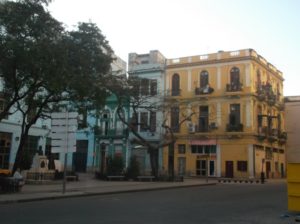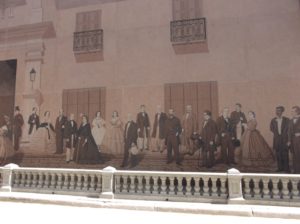About forty people gathered in the lower level meeting room of Jones Library for a program which began at 6:30 this evening. Kristen Sykes of the Appalachian Mountain Club (which has an office in Amherst) spoke first. She described some of AMC’s work in the region, including supporting the Connecticut River Paddlers’ Trail, a 300 mile “blue trail” from New Hampshire to Elwell Island in Northampton. The near-term goal, she explained, is to have campsites every 5 miles or so; the eventual goal is for paddlers to be able to travel on the river from New Hampshire all the way to Long Island Sound.
Norm Sims, the evening’s featured speaker, recently published a book with Mark Neuzil, Canoes: A Natural History in North America, with a forward by John McPhee, dean of American narrative non-fiction writers. According to the publicity blurb for this event:
Norman Sims is a retired honors professor from the University of Massachusetts-Amherst and a past president of the International Association for Literary Journalism Studies. This is his sixth book. A longtime whitewater canoeist and an active member of both the Appalachian Mountain Club and the Wooden Canoe Heritage Association, Sims has a small collection of antique Morris wood-and-canvas canoes.
Interestingly, to me especially, Mr Sims began his story with Hawaiian canoes. Polynesians paddled these double-hulled canoes from the Marquesas north a thousand miles to settle the Hawaiian Island chain. These canoes were basically floating farms, as on the central platform the mariners carried both plants and animals, everything they would need to start a new life, in that the Hawaiian Islands were basically barren, in terms of the resources available to support human settlement.
In North America proper, canoes have been part of the continent’s culture for thousands of years; there is evidence of canoe use from at least 5,000 years ago and maybe even as far back as 10,000 years. In fact, there are only two technologies that were developed in North America which have not been eroded by European culture: the canoe and snowshoe,
In the Pacific Northwest, canoes were the mainstay of the sea otter fur trade, as they were for the beaver fur trade in the continent’s Northeast. Haida dugout canoes were, and are, magnificent works of art and a pinnacle of cultural expression, though their primary use was for sea-going commerce.
Mr Sims showed slides of the first known drawings of canoes from the Northwest: a 1590 canoe made from cedar. In the Pacific Northwest, forests of thousand-year-old trees flourished. The Native Americans burned the bases of these trees to fell them; they also used stone blades. After the trees fell, they hollowed out the logs; clearly, making these dugouts was a long and difficult process.
On the opposite side of the continent, Native Americans constructed birch bark canoes; they stripped bark from the trees and turned it inside out to make their canoes. Birch bark is easier to work with, as birch wood is much softer than cedar. Four hundred years ago, if you lived in eastern Canada or in the Northeastern colonies, or westward as far as what is now Minnesota, birch trees grew in profusion. Birch bark canoes were lighter than cedar ones, but they could still carry thousands of pounds of cargo and could also be portaged.
Another slide Mr Sims showed depicted a Penobscot canoe from 1820, held by the Peabody Essex Museum, which was the property of a sea captain. These canoes are not particularly old, as birch bark doesn’t last long. The oldest extant birch bank canoe is the Innis canoe from 1760, held by the Canadian Canoe Museum in Peterborough, Ontario.
Canoes, Mr Sims emphasized, were intertwined with the dark history of the settlement of North America by Europeans. The fur trade, he reminded us, was the driving force for the settlement of North America; the other evils visited upon the world by the European colonization of North America were plantation slavery, rum, and tobacco.
The third type of canoe Mr Sims discussed is the all-wood canoe from the 1850s; a popular type was the three-board canoe. All wooden canoes were recreational, in contrast to cedar and birch bark canoes which were working canoes. A notable historical example of the wooden canoe is the Nessmuk, a very light canoe now owned by the Smithsonian Institution.
Wood canoes were difficult to keep in shape, so people began to cover them in canvas; these canoes got re-canvassed every twenty years or so. But canvas is not waterproof and has to be treated with a liquid which takes three weeks to dry. At that point, the canvas can be painted — Mr Sims pointed out that some of these painted canoes are simply beautiful.
Modern canoes began to be constructed of aluminum; these became popular around World War II (an example would be the Tripper from Old Town Canoes). Today, the material of choice is a plastic composite: fiberglass, Kevlar, graphite, or some other material like polyethylene.
Although this fact is easy to overlook, canoes are part of our cultural history. For example, from around the 1880s and 1890s until World War I, the “courting canoe” was enormously popular. Why? Canoes can’t easily fit three people, so couples took to the canoes to get away from chaperons. Both men and women dressed up to canoe, and some of these vessels were quite fancy: canoes had phonographs, were decorated with bunting and the American flag, or had lanterns both fore and aft. The couple in the canoe faced each other, but they weren’t supposed to be physically intimate (in fact, they could be fined for kissing). If not for the photographs of courting canoes on Boston’s Charles River in 1919 and from Detroit’s Belle Islands in 1900, I might have doubted the popularity of this activity, which now seems quaint and outmoded.
From advertisements in canoe catalogs, a social historian might infer the changing role of women in society. Contrast an ad from the Morris Canoe Catalog from 1917 with an ad for Old Town Canoes from 1919 and 1923; in the later catalogs, women are depicted as independent spirits.
Mr Sims ended this portion of his talk with some video clips of canoe stunts — a running canoe launch and a canoe flip — which I’m pretty sure were not doctored, in which case they’re kind of amazing.
Before he ended his talk, Mr Sims spoke earnestly about canoes and the environment, using two recent examples of people I would call “canoe heroes.”
On Dominica in the Caribbean, Napolean Sanford lives near the 3700 acre Carib Reserve, or Kalinago Territory, on the Atlantic side of the island nation; he builds traditional dugout canoes from the Gommier trees (Dacryodes hexandra). When Hurricane David struck the island in 1979, it destroyed all the boats, so Napolean started building them again. Earlier this year, Hurricane Maria, the same hurricane which did so much damage to Puerto Rico, struck Dominica hard, but Dominicans are still faring a bit better than our fellow American citizens. The reserve needs funds for recovery; if you can, please donate to help the recovery of Carib Reserve.
In our own country, Boundary Waters Canoe Area Wilderness in northern Minnesota lies across from Quetico Provincial Park in Canada, the whole comprising more than a million acres of wilderness. A couple, Dave and Amy Freeman, are consummate adventurers who decided to spend a year living in the Boundary Waters Wilderness, from September 2015 to September 2016, using only canoes, dog sleds, and cross-country skis to get around. Their concern was with a proposed sulfite-ore copper mine to be sited at the wilderness edge; in 2014, to commemorate the 50th anniversary of the Wilderness Act, they had paddled a 20-foot Wenonah canoe, signed by about 2000 people who oppose construction of the mine, from Ely, Minnesota to Washington DC. Did this action make a difference? You decide, because the debate over wilderness preservation is by no means over.
To encourage people to engage with the National Scenic Trail in our area and be moved to protect the environment, AMC has sponsored artists-in-residence, including photographers, poets, and musicians, among them the next person on the program, Ben Cosgrove:
Ben Cosgrove is a young composer, essayist, and multi-instrumentalist whose work is guided by his deep interests in landscape, place, and ecology. He has performed all over the country and released several well-received albums of original music, and his writing has appeared in Orion, Northern Woodlands, Appalachia, and other publications. In the past he has collaborated with the National Park Service, the National Forest Service, the Schmidt Ocean Institute, and other organizations, and he has held fellowships at Middlebury College, Harvard University, and the Vermont Studio Center. In 2017-18, Ben is working as an artist-in-residence with the New England National Scenic Trail, a long-distance hiking trail linking Long Island Sound to New Hampshire.
I really enjoyed the music Ben played for us this evening; the pieces were like tone poems, and I could imagine the landscapes evoked in his album Salt, which explores estuaries, tidal rivers, lakes, and other such places.





















